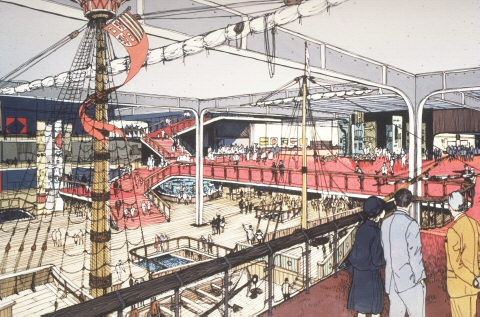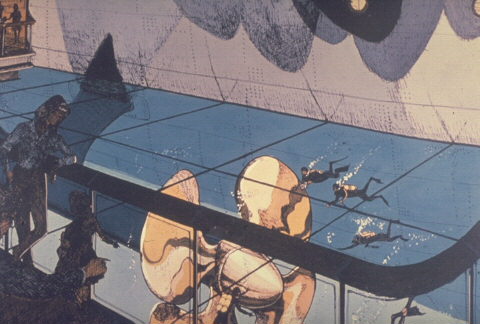

One of the original proposals for the museum on board the Queen Mary. Though the whole colored area was cleared, only the area aft of and including the Museum of the Sea (in blue) was ever actually used. Click on the map to see greater detail.
Phenomena of the Sea Theatre 10,500 Sq Feet (Orange on plan) This was conceived as a 300 seat theatre which would show a short multi screen film of the sea using only sounds and no commentary. Screens were to be located on the walls and floor, and the audience was to be suspended on a clear platform 12 feet above the floor. Special lighting, wind and fog machines would have added to the effects. Work on constructing this never started. The area is empty today.
Heritage of the Sea - 21,000 Sq feet (Green on plan) The centerpiece of this area (the old boiler rooms 3 & 4 and the after turbo-generator room) was a full size reproduction of magellan's 110 ton ship "Trinidad" surrounded by a dozen other exhibit areas describing ship design, ship culture and mythology, oceanographic research, naval warfare, safety and more. Again, this was never constructed. The area is empty today.

An artist's impression of what "Heritage of the Sea" would have looked like.
Highways of the Sea (7,800 square feet (Between Blue and Green areas on plan)
To be constructed in part of the after turbo-generator room, the main feature of this area was a walk-in theatre which showed the view from a ship's bridge during various different types of weather as it entered New York harbor.
Horizons of the Sea
Occupying boiler room 5 and the forward engine room spaces, this is the only area of the ship's lower areas (apart from the Queen Mary Story) which was actually finished. This area looked much more modern and scientific compared to the Heritage area.
Jacques Cousteau acted as chief designer for this section of the museum, the "Museum of the Sea" as it was called. It opened in July 1971. Visitors entered through a "water tunnel" which showed how important water was to life on Earth. They then came to an exhibit area called Water Planet which described the various different kinds of life in the ocean. On the lower deck were exhibits called "Crops from the sea", "Procreation", "Quest for Food", "Propulsion" and "Invisible Messages" On the middle level was a model of Dr Dranuc (Cunard spelled backwards) who was supposed to be the ocean explorer of the future. The upper level dealt with "Pollution", "Changing California Coastline", and "Oceanography Today". The Cousteau Museum incorporated parts of the areas forward of this that were never built. By this time, cost overruns had crippled the operation, and there was no hope of building these areas. They were sealed off and left as they were after clearing.
The Queen Mary Story The only area of the lower decks museum still open today, incorporating a self-guided tour of the After-engine room, steering gear, and propeller box.

How the propeller exhibit was conceived. See how it looks today on the "Virtual Tour" on this site.